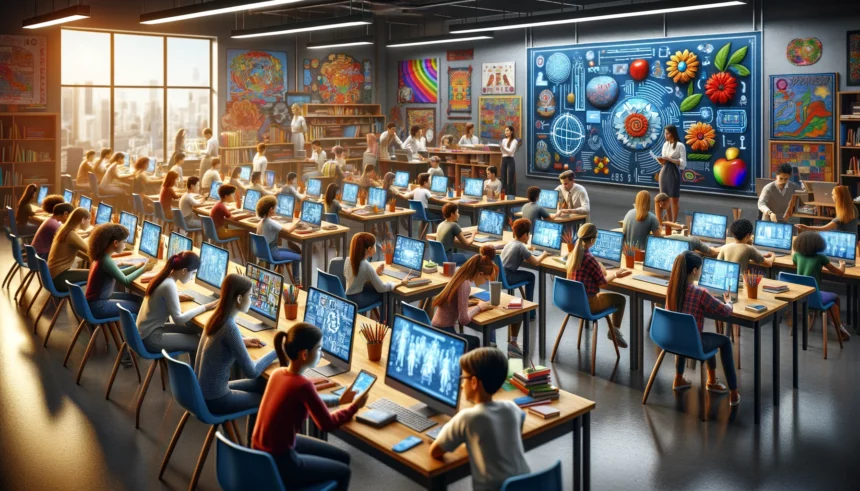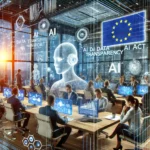Cultural studies in the digital age has woven itself into the educational landscape, encouraging us to explore the synergy between technology and teaching. As educators, we’re navigating a myriad of online tools, each designed to create more dynamic and interactive learning environments. The goal is to find resources that not only engage but also deepen students’ understanding of our diverse world. This is particularly challenging as we aim to connect with a generation that has grown up with digital technology.
The Essence of Cultural Studies
Adapting to Digital Advancements: Teaching cultural studies today means keeping up with technological progress while addressing the digital divide. We need to ensure that our teaching methods reflect the evolving narratives of digital literacy. Integrating engaging digital resources requires us to also develop effective communication strategies, tailored assessment methods, and professional development platforms.
Michelle Connolly, founder of LearningMole, with 16 years of classroom experience, sums it up well: “Adapting to the digital age doesn’t just mean using new tools; it means thinking differently about teaching and learning.”
Key Points to Remember
- Utilizing Online Resources: It’s essential for teaching cultural studies effectively.
- Addressing the Digital Divide: Ensuring technology benefits all learners is crucial.
- LearningMole’s Role: Providing engaging and inclusive learning resources exemplifies the evolution of digital education.
Evolution of Digital Education
At LearningMole, we’ve witnessed the shift from traditional teaching methods to digital education. Digital platforms enable interactive learning environments that adapt to individual student needs. This approach fosters a sense of community and involvement among educators and learners, making everyone a participant in the learning process.
Core Concepts in Cultural Studies: Digital literacy is essential in cultural studies, allowing learners to navigate and engage with digital content critically. Our resources aim to cultivate analytical skills, enabling educators and learners to dissect and reconstruct cultural products. Michelle Connolly often emphasizes that “Digital literacy is as crucial as traditional literacy in today’s classrooms, as it empowers learners to sift through vast information efficiently and effectively.”
Technological Advancements in Education
EdTech Revolution: Educational technology (EdTech) uses digital tools and resources to facilitate learning and improve educational processes. We’ve seen a surge in virtual classrooms, interactive e-books, and personalized learning experiences. These tools are reshaping education by providing interactive content across multiple subjects.
Emerging Digital Technologies: New technologies like augmented reality (AR) and virtual reality (VR) offer immersive learning experiences. Artificial intelligence (AI) tailors lessons to student performance, and robotics teach programming through hands-on activities. These innovations engage children in STEM subjects by making complex ideas approachable and fun.
Bridging the Digital Divide
Equal Access to Technology: Providing equal access to technology and high-quality digital resources is vital. At LearningMole, we equip educators and learners with the tools they need, ensuring no student is left behind. Our online resources cover basic mathematics to complex STEM subjects, designed to be accessible for all.
Digital Competence: Digital competence means more than just using devices; it’s about navigating, evaluating, and creating information online. We advocate for a curriculum that integrates digital skills across all subjects. Our tutorials and interactive materials enhance students’ digital literacy, preparing them for the future.
Engaging Digital Resources for Educators
Selecting the Right Tools: Choosing the right digital tools can be daunting. Focus on resources that cover diverse curricula and cater to different learning styles. LearningMole curates educational materials to foster a deeper understanding of various subjects through interactive tutorials, articles, and activity sheets.
Khan Academy’s Role: Khan Academy provides free, high-quality educational resources that cover historical events, literary analysis, and artistic movements. Its interactive exercises and video tutorials encourage student participation, making abstract ideas more accessible.
Integrative Approaches to Online Learning
Blended Learning Models: Blended learning integrates online education with face-to-face methods, providing a flexible learning approach. Models like the rotation model allow students to alternate between online tasks and in-class instruction, while the flex model uses online learning as the backbone of education with teacher support as needed.
Fostering Collaborative Learning: Technology opens up vast opportunities for collaborative learning. Online forums, shared documents, and interactive platforms allow students to work together, building knowledge and developing social and emotional skills.
Effective Communication in Digital Learning Spaces
Building Communities of Practice: Developing a Community of Practice (CoP) is fundamental in digital learning spaces. We focus on nurturing relationships among educators to share expertise and strategies, fostering a supportive network.
Enhancing Teacher-Student Interaction: Interactive tutorials make complex topics approachable and exciting, ensuring student engagement. Michelle Connolly highlights that “Student engagement spikes when they interact with content that resonates with their interests and challenges them just the right amount.”
Assessment and Learning Outcomes in the Digital Realm
Modern Assessment Techniques: Online quizzes with instant feedback allow us to gauge students’ understanding in real-time. These techniques assess knowledge and provide data to tailor subsequent teaching materials and methods.
Measuring Learning Effectiveness: Beyond test scores, we focus on critical thinking, problem-solving, and digital literacy. Online platforms like LearningMole provide resources that foster a deep understanding of subject matter, making the assessment of knowledge and skills more comprehensive.
Professional Development for Digital Age Educators
Continuous Learning for Educators: Professional development is crucial for staying relevant and effective in teaching practices. LearningMole offers webinars and courses to help educators continuously build their skills and knowledge.
Promoting Digital Literacy Among Teachers: To resonate with digital-age students, educators must enhance their digital literacy. LearningMole provides resources to help teachers integrate technology into their curriculum confidently.
Digital Citizenship and Sustainable Development
Promoting Social Capital Through Education: Teaching digital citizenship involves developing social capital, which is vital for navigating online communities. Our resources support educators in teaching students to engage respectfully and constructively online.
Education’s Role in Sustainable Development: We emphasize sustainability in digital education, teaching students responsible digital habits. Our lesson plans cover environmental stewardship and sustainable practices in digital consumption and creation.
Policy, Research, and Practice
Influencing Educational Policy: We strive to influence educational policy to ensure digital resources are integral components of the curriculum. Michelle Connolly notes that aligning educational policy with the digital landscape paves the way for meaningful technology integration.
Connecting Research with Classroom Practice: Our content integrates evidence-based research with practical application, ensuring that resources inform and inspire. Engaging with policymakers and aligning practice with the latest research helps us provide a platform that meets teachers’ and students’ needs.
Frequently Asked Questions
How can teachers incorporate multicultural resources in their digital classrooms? Introduce a variety of multimedia resources reflecting different cultures. Online platforms like LearningMole offer diverse content to enrich lessons with cultural diversity.
What are the best practices for utilizing digital media in teaching and learning? Blend dynamic visuals, engaging narratives, and interactive tasks. Consistency and relevance in digital content delivery are key to creating a captivating learning experience.
How does the Internet enhance educational opportunities for both teachers and students? The Internet offers a wealth of information, providing access to global perspectives and resources. It breaks barriers, fostering a more interconnected educational experience.
Why is it essential to integrate cultural studies into digital education? Embedding cultural studies into digital education fosters understanding and respect for diversity. It prepares students to thrive in a globally connected world.
What digital resources are available for teachers to help students learn about different cultures? Digital resources include virtual museum tours, online literature, and curated educational materials from platforms like LearningMole, which help students explore and appreciate cultural diversity.
How has the impact of the Internet on education been addressed in recent research papers? Research papers highlight the Internet’s transformative role, expanding educational access and personalizing learning experiences. The Internet encourages a collaborative approach to learning, shifting towards more interactive and personalized education.
4o
















